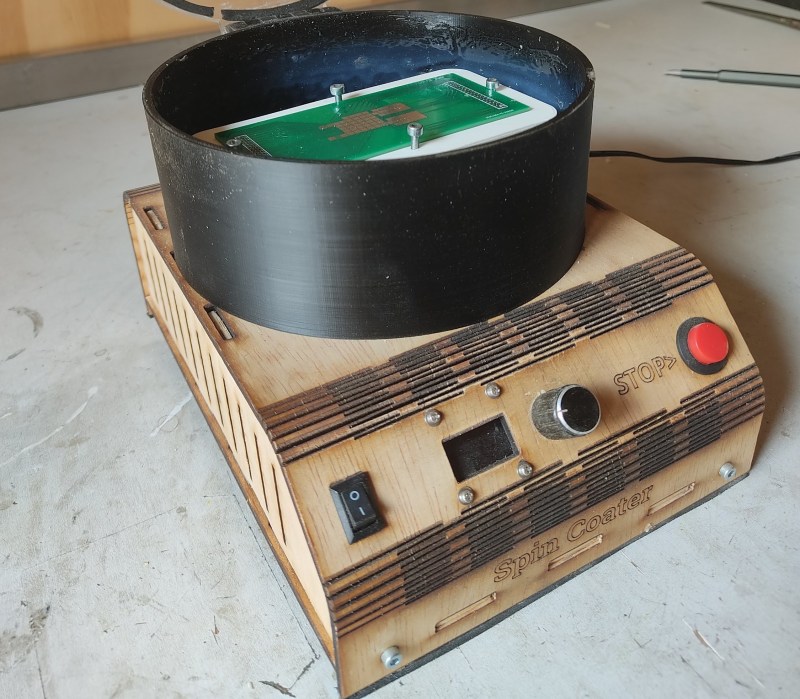One of the great things about the Gearing Up challenge of the 2023 Hackaday Prize is that it lets you discover tools that you don’t encounter every day. We had never given much thought to spin coaters, for example, until we saw [Jeroen Delcour]’s neat homebrew example. As it turns out, spin coating has lots of applications in fields like optics, semiconductor manufacturing or even art projects, where a thin, even layer of a material is required on top of a flat substrate.
The basic idea behind a spin coater is simple: you dispense a few drops of a solution containing the material to be deposited on top of the thing you want to coat, then spin the thing around at a constant speed. The balance between the centripetal force and the liquid’s surface tension ensures that the liquid turns into a film with a consistent thickness all across the substrate. The solvent evaporates, and you’re left with a nice solid layer just a few microns thick.
[Jeroen] built his spin coater out of a brushless DC drone motor, a programmable motor controller, and an ESP32. A rotary pushbutton and an OLED form the user interface, allowing the user to select the speed and spin times. The electronics are all mounted inside a laser-cut wooden enclosure, with the motor sticking out the top, surrounded by a 3D-printed splash guard.
Professional spin coating equipment typically comes with a vacuum chuck to hold the sample in place, but [Jeroen] wasn’t too excited about implementing vacuum systems on a spinning platform and decided instead to simply clamp down the sample using screws in a laser-cut piece of acrylic. This works well enough, and is easy to customize for different sample sizes.
In the video embedded below, [Jeroen] experiments with applying a layer of silicone rubber onto a PCB. Spin coating is an essential step when you’re making your own semiconductor devices such as solar cells, though you might also need more complicated equipment such as an electron microscope. [Jeroen]’s spin coater is at least able to process much larger objects than one we saw earlier.


















I hope he has access to a good hand surgeon… Seems that the “barrier” is maybe PLA or PETG. If things fly apart, I do wonder about the safety. Aside from that, pretty cool project.
This was my first tought, too
One thing I never understood about spin coaters is how they control a uniform layer thickness.
In the center of the disk, the material is standing still, while the acelleration and G force increases linearly with the radius. So why is the layer thickness still uniform? This is for example also used in semi conductor industry, where layer thickness is very important. Could it be that you’ll just get a layer thickness of one (or n) molecules, which won’t get flung off regardless of G-force?
I had the same questions a couple of years ago when I encountered a home-brew spin coater in a lab I visited. This led me to a very helpful web page explaining it:
https://www.ossila.com/en-ca/pages/spin-coating
I built https://github.com/klotzsch-lab/Maasi which work decently using most of the same concepts. My main complaint is the 3d printed parts weren’t designed to print without supports and the standard orientation of the LCD blocks access to the SD card port, so I simply corrected the firmware to flip the screen over.
I have plans to consolidate all the parts in to a single PCB and make it wirelessly displayed and controlled on a mobile app, so will definitely be digging in to this one soon for further inspiration.
Damn, I somehow missed that repo in my research before building my own. Thanks for the tip. That specific design is too small for my purposes, but it would’ve been nice to have extra confirmation that this approach works well. Plus, it’s more fun to build your own from scratch :)
I remember having a spin-art toy when I was a kid. It’s probably illegal now due to kids losing fingers to it.
I miss those awesome toys. Those of us that survived them turned out stronger for it. I remember my grandpa getting me a chemistry set with chemicals that I now know if combined could start a fire.
In the UK these were sold as “Spiromatic”: https://tse3.mm.bing.net/th/id/OIP.475NbcyrG0W6cyNm0EDpWAAAAA?pid=ImgDet&rs=1
We used to stick round-ish bits of white cardboard to tje shaft of those small cheap 3VDC motors pulled from various toys with a blob of bluetac and colour them with coloured markers.